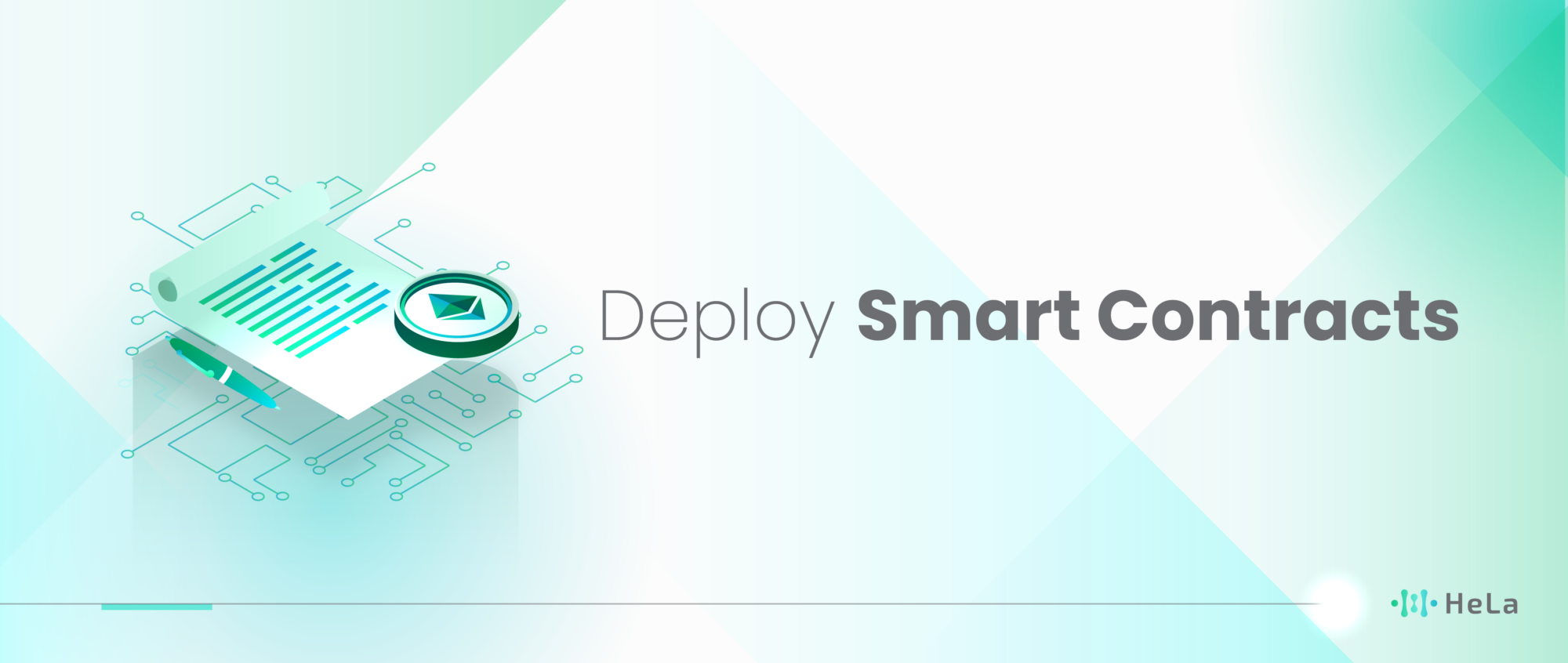In the world of blockchain and cryptocurrencies, smart contracts stand out as revolutionary tools that automate transactions and enforce agreements without the need for intermediaries. This guide is designed to walk developers through the process of deploying smart contracts, ensuring that even those new to the field can grasp the concepts and steps involved. With the blockchain industry evolving rapidly, understanding how to deploy smart contracts effectively is crucial for anyone looking to innovate in this space.
Deploying smart contracts can seem daunting at first, but with the right approach, it becomes a manageable and rewarding process. This guide aims to demystify the technical complexities and provide a clear roadmap for developers. By focusing on practical insights and drawing from real-world examples, we’ll ensure you have the knowledge needed to navigate the deployment process successfully.
Whether you’re looking to create decentralized applications (DApps), issue tokens, or automate processes, deploying smart contracts is a fundamental skill. This ultimate guide is tailored to help developers understand the intricacies of smart contract deployment, from writing and testing to finally deploying them on a blockchain network. Let’s embark on this journey together, unlocking the potential of smart contracts to innovate and transform digital transactions.
Understanding the Smart Contracts
Smart contracts represent a transformative technology in the digital landscape, akin to how the Internet revolutionized communication. At their core, these are programs that automate the execution of agreements, making the process faster and reducing the need for intermediaries such as lawyers or banks. This innovative approach to contracts leverages blockchain technology, providing a decentralized platform that ensures integrity and transparency.
The essence of a smart contract is its ability to be self-executing and self-enforcing. This means that once the contract’s code is deployed on the blockchain, it will automatically perform certain actions (such as transferring funds) once predefined conditions are met. For instance, in a simple sale transaction, the smart contract might automatically transfer ownership of a digital asset once payment is confirmed, without any human intervention.
Smart contracts operate on “if/when…then…” statements written into code on a blockchain. A blockchain is a distributed ledger, a kind of database that is shared across multiple sites, countries, or institutions, and records transactions in a secure, verifiable, and permanent way. This environment not only supports the execution of smart contracts but also ensures their outcomes are recorded transparently and immutably, making the contract tamper-proof and trustworthy.
Also Read: 12 Best Crypto Mining Companies to Explore in 2024
The applications of smart contracts are vast and varied, stretching across numerous sectors such as finance (DeFi), real estate, legal processes, and even in the creation of decentralized autonomous organizations (DAOs). Their ability to automate complex processes, ensure contractual conditions are unambiguously met, and significantly reduce the potential for fraud or third-party manipulation marks them as a significant innovation.
However, the adoption of smart contracts also presents challenges. The quality and security of a smart contract depend heavily on the precision of its code. Errors or vulnerabilities in the code can lead to disputes or exploitation. Moreover, the rigid nature of smart contracts means that once they are deployed, altering them can be difficult, necessitating thorough testing and validation before implementation.
Smart contracts herald a new era in digital transactions and agreements. By automating and securing contractual obligations via blockchain technology, they offer a pathway to more efficient, transparent, and secure systems. As the technology matures and the legal framework around it evolves, smart contracts are poised to become a fundamental component of digital and economic infrastructures worldwide.
Writing Your First Smart Contract

To begin writing your first smart contract, it’s crucial to understand that a smart contract is essentially a program stored on a blockchain that runs when predetermined conditions are met. These contracts are executed by the network of computers in the blockchain, which ensures they run exactly as programmed without any downtime, fraud, censorship, or interference from a third party.
Step 1: Choose Your Blockchain and Language
- Select a Blockchain: While Ethereum is the most popular platform for smart contract development due to its pioneering role and extensive developer support, there are other blockchains like Binance Smart Chain, Cardano, and Solana, each with its own smart contract capabilities and programming languages.
- Choose a Programming Language: Solidity is the primary language for Ethereum smart contracts and is similar in syntax to JavaScript. It’s designed for creating and deploying smart contracts on the Ethereum Virtual Machine (EVM). Other blockchains may use different languages, such as Vyper (an alternative on Ethereum), Rust (for Solana), or Plutus (for Cardano).
Step 2: Understand the Basics of Smart Contract Programming
- Variables: Just like in other programming languages, variables in smart contracts store data. They can be fixed (constants) or variables. The data types include integers, strings, booleans, and more complex structures like arrays and mappings.
- Functions: Functions are the building blocks of smart contracts. They define the contract’s behavior and how it interacts with transactions on the blockchain. Functions can be public (callable from outside the contract), private (only within the contract), or view/constant (do not modify the contract’s state).
- Control Structures: Smart contracts use control structures such as if-else statements, loops, and error handling to dictate the flow of execution. These are similar to control structures in other programming languages but must be used carefully to avoid unnecessary gas costs.
Step 3: Set Up Your Development Environment
- Install Necessary Tools: To start coding, you’ll need the right tools. For Ethereum and Solidity, popular choices include Remix (an online IDE), Truffle Suite (for testing and deploying contracts), and MetaMask (a browser extension for interacting with the Ethereum network).
- Write Your Contract: Start with a simple contract, such as a “Hello World” example, to get a feel for the syntax and structure. Gradually add complexity by introducing variables, functions, and control structures to suit your needs.
Step 4: Testing and Deployment
- Test Your Contract: Before deploying your contract to the main network, test it thoroughly on a testnet. Testing helps you find and fix bugs without risking real money.
- Deploy Your Contract: Once you’re confident in your contract’s functionality, you can deploy it to the blockchain. This involves compiling the contract and submitting it to the network, which will require a small fee in the blockchain’s native cryptocurrency.
Step 5: Interacting with Your Contract
- After deployment, users can interact with your contract through transactions on the blockchain. You can create user interfaces (UIs) or use existing tools like Etherscan for Ethereum contracts to make it easier for users to interact with your contract.
Writing your first smart contract involves choosing a blockchain and language, understanding smart contract programming basics, setting up your development environment, and then testing and deploying your contract. With these steps, you’ll be well on your way to creating functional and secure smart contracts.
Testing and Debugging Smart Contracts

In the world of blockchain development, smart contracts are self-executing contracts with the terms of the agreement directly written into code. They are pivotal for automating execution, facilitating, verifying, or enforcing the negotiation or performance of a contract. Given the immutable and distributed nature of blockchain, deploying a smart contract with bugs or vulnerabilities can have serious, irreversible consequences. Therefore, rigorous testing and debugging before deployment cannot be overstated.
Testing Smart Contracts
This involves running your contract under controlled conditions to check for any issues. Here’s a breakdown of the essential testing strategies:
- Unit Testing: This is the foundation of smart contract testing. Developers write tests for individual functions or components of the smart contract to ensure each part works as expected. These tests are automated and can be run every time a change is made, helping to catch errors early.
- Integration Testing: Beyond testing individual components, integration testing assesses how those components work together. This is crucial for smart contracts, as functions often interact in complex ways.
- Test Networks (Testnets): Testnets are critical for simulating the deployment of smart contracts under real blockchain conditions without the risk of losing actual funds. They mimic the behavior of the main network (mainnet) but use test currency, enabling developers to interact with their contracts in a live environment. This helps in understanding how contracts will perform when deployed on the mainnet.
Debugging Techniques
Debugging is the process of identifying, analyzing, and removing errors or anomalies in your code. For smart contracts, this process can be challenging due to blockchain’s immutable nature. However, several tools and practices can facilitate effective debugging:
- Static Analysis Tools: These tools analyze your code for patterns or signs of vulnerabilities without executing it. They can quickly identify common issues, saving developers time.
- Debugging Tools: Various blockchain platforms offer specialized debugging tools designed to work with smart contracts. These tools allow developers to step through their code, inspect variables, and understand the contract’s state at different execution points.
- Security Audits: Before deploying a smart contract, a thorough security audit conducted by external experts can identify vulnerabilities that the original developers might have missed. While audits are not strictly a ‘debugging technique,’ they are a crucial step in ensuring the security of smart contracts.
Best Practices
In addition to these tools and strategies, adhering to best practices in coding and contract design is essential. This includes writing clear, simple, and well-documented code; adhering to established patterns and practices for smart contract development; and staying informed about the latest security concerns and how to mitigate them.
Testing and debugging smart contracts are iterative processes. Developers should continuously test and re-test their contracts throughout the development lifecycle. By leveraging the right tools and practices, developers can significantly reduce the risk of deploying flawed smart contracts, ensuring they are robust, secure, and perform as intended on the blockchain.
Choosing a Blockchain Platform for Deployment
When considering the deployment of a smart contract, selecting the right blockchain platform is a critical decision that impacts not just the contract’s functionality and cost, but also the potential audience it can reach. In the realm of blockchain technology, a plethora of platforms exist, each with its unique features, advantages, and limitations. Popular choices include Ethereum, known for its widespread adoption and robust developer community; Binance Smart Chain (BSC), favored for its low transaction costs and high throughput; among others. These platforms cater to various needs and project specifications, making the choice of platform an integral part of your project’s planning and execution phase.
Adding to the spectrum of available blockchain platforms, HeLa Labs presents itself as an emerging contender worth considering. HeLa Labs is not just a blockchain platform; it’s a comprehensive ecosystem designed to support the development and deployment of smart contracts and decentralized applications (dApps). The platform aims to offer an optimized balance between scalability, security, and decentralization, addressing some of the common challenges faced by developers on other blockchain networks.
Key considerations when choosing a blockchain platform like HeLa Labs or others include:
- Transaction Costs: Evaluate the cost associated with executing transactions and deploying smart contracts. Platforms like BSC offer lower fees compared to Ethereum, but emerging platforms might provide even more competitive pricing structures.
- Scalability: The ability of the blockchain to handle a high volume of transactions without significantly impacting speed or cost is crucial, especially for applications expecting high user traffic.
- Security: Consider the platform’s security features and history of vulnerabilities or attacks. The underlying consensus mechanism and network participation can affect security levels.
- Developer Ecosystem and Tools: A rich developer ecosystem and comprehensive tooling can significantly ease the development process. Look for platforms with active communities, documentation, and development frameworks.
- Compatibility and Interoperability: For projects aiming to interact with multiple blockchains, the platform’s compatibility with other networks and support for interoperability protocols is important.
- Audience Reach: Some platforms may offer better access to your target audience. Ethereum’s wide adoption makes it a popular choice, but niche platforms can provide targeted communities with specific interests.
The choice of a blockchain platform for deploying your smart contract is a critical decision that requires careful consideration of various technical, economic, and strategic factors. By understanding the unique features and trade-offs of each platform, you can select the one that best aligns with your project’s goals and requirements.
Deploying Your Smart Contract

Deploying your smart contract is a critical phase in the development process, marking the transition from development and testing to live operation. This comprehensive guide will help you navigate the deployment process smoothly and effectively. Here’s a breakdown of the key steps and considerations involved:
1. Pre-Deployment Preparation
- Audit Your Contract: Ensure your smart contract code has been thoroughly audited for security vulnerabilities and logic errors. Consider engaging a third-party audit firm for an unbiased review.
- Optimize for Gas Efficiency: Minimize the cost of transactions by optimizing your contract code for gas efficiency. This can involve simplifying functions, reducing state changes, and other optimizations.
- Select a Blockchain Network: Choose the appropriate blockchain network for deployment, considering factors like transaction speed, cost, and the network’s user base. Popular options include Ethereum Mainnet, testnets (Ropsten, Rinkeby), and Layer 2 solutions.
2. Setting Up Your Development Environment
- Install Necessary Tools: Ensure you have the required development tools installed, such as Truffle, Hardhat, or Remix for Ethereum smart contracts.
- Configure Your Wallet: Set up a cryptocurrency wallet that supports your chosen blockchain. You’ll need this to pay for transaction fees associated with deploying your contract.
- Obtain Testnet Tokens: If deploying to a testnet first (highly recommended), acquire testnet tokens from a faucet to cover deployment costs without spending real cryptocurrency.
3. Connecting to a Blockchain Network
- Select a Provider: Choose a blockchain node provider, like Infura or Alchemy, to connect your development environment to the blockchain network.
- Configure Network Settings: Update your project’s configuration files (e.g., truffle-config.js for Truffle projects) with the details of the chosen network and your access node.
Also Read: 5 Best ERC404 Projects in Web3 for 2024 (Updated List)
4. Deploying Your Smart Contract
- Compile Your Contract: Use your development tool to compile the smart contract, checking for any last-minute errors or issues.
- Deploy: Execute the deployment script or command that interacts with the blockchain network to deploy your contract. Monitor the transaction for success or failure.
- Verify and Publish Your Contract Code: (Optional, but recommended) Verify your contract on block explorers like Etherscan to make it easier for others to interact with and audit your contract.
5. Post-Deployment
- Monitor Transactions: Use tools and block explorers to monitor transactions to and from your smart contract, ensuring everything is working as expected.
- Interact with Your Contract: Test the deployed contract’s functions through direct interactions or frontend applications connected to it.
- Implement Versioning and Upgrades: If your contract is designed to be upgradable, plan for how and when you might implement changes or new features.
Additional Considerations
- Cost Management: Keep an eye on transaction fees (gas prices) and optimize your interactions to manage costs effectively.
- Security Measures: Continuously monitor for security vulnerabilities and be prepared to take quick action in case of an incident.
- Community and User Support: Establish channels for user feedback and support, facilitating a community around your project.
Deploying a smart contract is a significant step, and it’s important to proceed with caution, thorough preparation, and an eye toward security and efficiency. This guide outlines a framework for deployment, but always stay informed about best practices and developments in the blockchain space to enhance your deployment strategy.
Conclusion
Deploying smart contracts is a journey that requires careful planning, coding, and testing to ensure success. Throughout this guide, we’ve aimed to equip developers with the knowledge and tools needed to navigate this process. Remember, the deployment of a smart contract is not the end but the beginning of its lifecycle. Monitoring performance, updating code, and engaging with users are ongoing tasks.
The blockchain landscape is continually evolving, and with it, the possibilities for smart contracts expand. Staying informed, experimenting with new ideas, and learning from the community are essential for developers looking to make their mark in this exciting field. As you embark on your smart contract deployment projects, keep in mind the power of these digital agreements to innovate and streamline processes across industries.
We hope this guide serves as a valuable resource, helping you understand the nuances of deploying smart contracts and empowering you to create secure, efficient, and impactful blockchain applications. Happy coding, and here’s to the exciting possibilities that lie ahead in the world of smart contracts!
Disclaimer: The information provided by HeLa Labs in this article is intended for general informational purposes and does not reflect the company’s opinion. It is not intended as investment advice or recommendations. Readers are strongly advised to conduct their own thorough research and consult with a qualified financial advisor before making any financial decisions.

Joshua Soriano
I am Joshua Soriano, a passionate writer and devoted layer 1 and crypto enthusiast. Armed with a profound grasp of cryptocurrencies, blockchain technology, and layer 1 solutions, I've carved a niche for myself in the crypto community.
-
Joshua Soriano#molongui-disabled-link
-
Joshua Soriano#molongui-disabled-link
-
Joshua Soriano#molongui-disabled-link
-
Joshua Soriano#molongui-disabled-link

